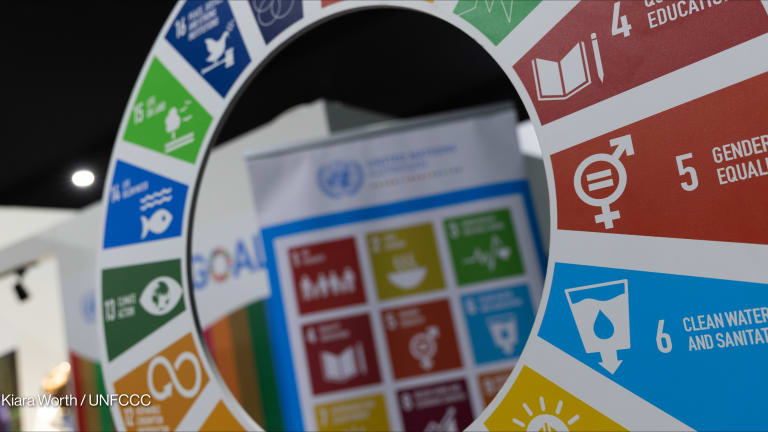'Digital strategy is no longer optional': How nonprofits are using the cloud
As organizations adapt their programs to provide services and track impact from a distance, cloud technologies are becoming even more central to their work.
SAN FRANCISCO — Many nonprofits seeking to save time and money have migrated to the cloud, opting for tools developed by large companies rather than managing their own servers. Cloud computing, the use of a network of internet-based data services, offers nonprofits an alternative to on-site data storage and system management. Now, as organizations adapt their programs to provide services and track impact from a distance, cloud technologies are becoming even more central to their work. Nonprofits shared their experiences using cloud technologies, both leading up to and during the COVID-19 pandemic, and offered advice for other organizations seeking to migrate to the cloud at “IMAGINE: Nonprofit Online,” a virtual conference hosted last week by Amazon Web Services. The cloud enables AtmaGo, a website and mobile app that features user-generated posts and emergency alerts, to provide real-time, crowdsourced, peer-to-peer information efficiently and affordably in Indonesia and Puerto Rico. Next year, Atma Connect plans to use machine learning and artificial intelligence to provide critical information to communities that are vulnerable to disaster, according to Meena Palaniappan, founder and CEO of Atma Connect, the nonprofit behind AtmaGo. In response to the pandemic, Atma Connect has launched a specialized COVID-19 website, created a free telecounseling service to address rising anxiety from lockdowns, and amplified community-centered content to change behavior and slow the spread of the coronavirus, she said. Atma Connect has contracts with large, international nongovernmental organizations including The Nature Conservancy, Mercy Corps, and the Red Cross. “What we offer to these organizations is connection to the front lines,” Palaniappan told Devex. “What we’re able to do is create communities that are able to take action on the ground immediately.” One of the reasons this nonprofit that launched just five years ago is in a position to partner with large INGOs is that it is “digital-first,” Palaniappan said: “There is an opportunity to reach massive scale on digital.” Nonprofits that may not identify as digital-first often undergo what they describe as digital transformation, and the COVID-19 pandemic is bringing a renewed sense of urgency to these efforts. Seek out services from tech companies The Nature Conservancy is in the process of migrating its on-premises server network of geospatial conservation data to a centralized cloud platform that will make this data more accessible. “With COVID-19, it is increasingly difficult for our field programs to get to an office where they can access their on-premise server within a Wide Area Network,” Zach Ferdana, geospatial information officer at The Nature Conservancy, told Devex via email. “Remote desktop access from home to the cloud can be achieved by following the organization’s security protocols in order to gain access to their geospatial data.” The Nature Conservancy is using technology from Amazon Web Services and Esri, the geographic information system software company. Tech companies are usually willing to help nonprofits create prototypes of cloud platforms through donated “cloud credits” and grant programs, Ferdana said. And for conservation organizations, there are an increasing number of opportunities to leverage Earth observation data, as vendors of software as a service work with imagery companies to negotiate nonprofit rates. “With the ubiquity of mobile phones and the changes to how we meet in person, a thoughtful mobile strategy is essential.” --— Mark Boots, co-founder and chief technology officer, Viamo Listen, test, iterate The combination of mobile phones and cloud technology has the potential to give people around the world a say in the design of development programs — but only if organizations are listening. Viamo, a social enterprise that uses mobile technology to create feedback loops aimed at improving development outcomes, created the “3-2-1 service,” a free, on-demand information service, in partnership with mobile network operators in 18 countries. “I often describe it as ‘Wikipedia lite’ for basic phones and people with lower literacy,” said Mark Boots, co-founder and chief technology officer at Viamo, during his presentation at last week’s conference. People can call or text for information such as news, weather, nutrition, and now COVID-19, he said before diving into the technical details of the service, which involves in-country hardware communicating with the Amazon Web Services cloud. “A digital strategy is no longer optional,” Boots said. “With the ubiquity of mobile phones and the changes to how we meet in person, a thoughtful mobile strategy is essential.” He also noted the importance of identifying win-win partnerships. The 3-2-1 service reached scale while remaining free for end users and content providers because of the unique value proposition it provides to mobile network operators, he said. Finally, Boots emphasized the importance of user-centered design. “There have been a lot of cases where we didn’t master what would work at the start, especially given the diversity of groups, populations, and countries we serve. However, through feedback and iteration, we keep improving results,” he said. Boots advised organizations to start by listening and to do user research and field testing before starting new services. Consider how the data will be used “Internet of Things,” or IoT, refers to the growing number of devices that are connected to the internet. For nonprofits, the combination of cloud technology and IoT has the potential to narrow the gap between data and action. By adding sensors to products ranging from tractors to refrigerators, they can track performance and fix problems as they arise. The nonprofit organization charity: water is piloting a program using IoT technology to monitor water pumps in remote areas. Together with partners, it has developed sensors that connect 7,300 water pumps to the cloud, allowing for real-time tracking rather than in-person site visits, which are costly, time-consuming, and risky in the context of COVID-19. These devices equip NGO partners in Ghana, Malawi, Ethiopia, and Nepal to monitor the health of these water pumps. “There is the technical problem: getting data from point A, the cloud, to point B, the guy in the field with low internet bandwidth,” Christoph Gorder, chief global water officer at charity: water, told Devex. “The bigger challenge is: How do you get this data to be used?” Charity: water uses a system of email reports that go out daily and weekly with graphics capturing takeaways from the data as well as files with the raw data. There are issues when it comes to the ecosystem around maintenance, as well as key questions like who pays for repairs, but devices like these are a step in the right direction, Gorder said. The importance of hand-washing in the COVID-19 response has made governments more interested than ever in monitoring the status of water infrastructure in rural areas. Cloud and IoT technologies can help provide them with the data they need, Gorder said.
SAN FRANCISCO — Many nonprofits seeking to save time and money have migrated to the cloud, opting for tools developed by large companies rather than managing their own servers.
Cloud computing, the use of a network of internet-based data services, offers nonprofits an alternative to on-site data storage and system management. Now, as organizations adapt their programs to provide services and track impact from a distance, cloud technologies are becoming even more central to their work.
Nonprofits shared their experiences using cloud technologies, both leading up to and during the COVID-19 pandemic, and offered advice for other organizations seeking to migrate to the cloud at “IMAGINE: Nonprofit Online,” a virtual conference hosted last week by Amazon Web Services.
This story is forDevex Promembers
Unlock this story now with a 15-day free trial of Devex Pro.
With a Devex Pro subscription you'll get access to deeper analysis and exclusive insights from our reporters and analysts.
Start my free trialRequest a group subscription Printing articles to share with others is a breach of our terms and conditions and copyright policy. Please use the sharing options on the left side of the article. Devex Pro members may share up to 10 articles per month using the Pro share tool ( ).
Catherine Cheney is the Senior Editor for Special Coverage at Devex. She leads the editorial vision of Devex’s news events and editorial coverage of key moments on the global development calendar. Catherine joined Devex as a reporter, focusing on technology and innovation in making progress on the Sustainable Development Goals. Prior to joining Devex, Catherine earned her bachelor’s and master’s degrees from Yale University, and worked as a web producer for POLITICO, a reporter for World Politics Review, and special projects editor at NationSwell. She has reported domestically and internationally for outlets including The Atlantic and the Washington Post. Catherine also works for the Solutions Journalism Network, a non profit organization that supports journalists and news organizations to report on responses to problems.




